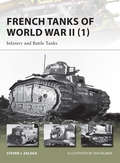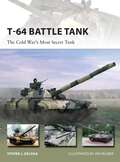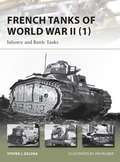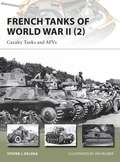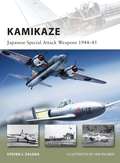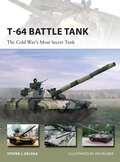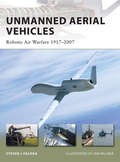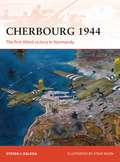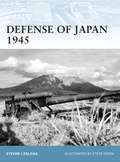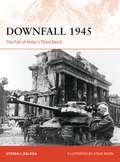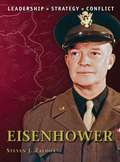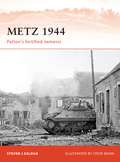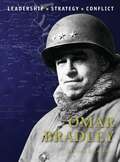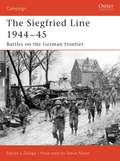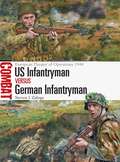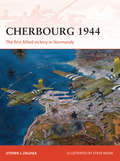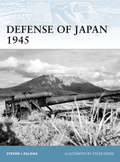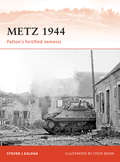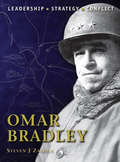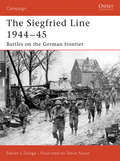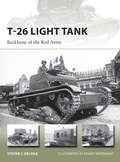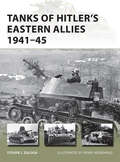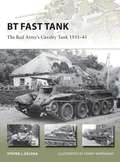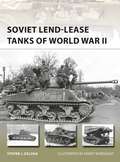- Table View
- List View
French Tanks of World War II: Infantry and Battle Tanks (New Vanguard #209)
by Steven J. Zaloga Mr Ian PalmerThe first of two volumes covering the French armor of World War II, this title looks at the infantry and battle tanks that faced the onslaught of the German Blitzkrieg in 1940. Many of the French tanks were intended as replacements for the World War I-era Renault FT, and various modernization efforts throughout the inter-war years had given rise to a number of new infantry tanks, including the Renault R35 and R40, FCM 36, and the Hotchkiss H35 and H39. Alongside these developments was a separate family of battle tanks, starting with the Renault D1, D2, and, finally, the best-known French tank of the campaign – the Char B1 bis. French Tanks of World War II (1) offers a background to the design and development of these tank types, and an evaluation of their performance in the Battle of France.
T-64 Battle Tank: The Cold War’s Most Secret Tank (New Vanguard #223)
by Steven J. Zaloga Mr Ian PalmerThe T-64 tank was the most revolutionary design of the whole Cold War, designed to provide the firepower and armour protection of a heavy tank in a medium-weight design. It pioneered a host of new technologies including laminate armour, stereoscopic tank rangefinders, opposed-piston engines, smooth-bore tank guns with discarding sabot ammunition, and gun-fired guided projectiles. These impressive features meant that the Russians were loath to part with the secrets of the design, and the T-64 was the only Soviet tank type of the Cold War that was never exported. Written by an armour expert, this detailed technical history sheds light on the secrets behind the Cold War's most controversial tank, revealing how its highly advanced technologies proved to be both a blessing and a curse.
French Tanks of World War II: Infantry and Battle Tanks (New Vanguard)
by Steven J. Zaloga Ian PalmerThe first of two volumes covering the French armor of World War II, this title looks at the infantry and battle tanks that faced the onslaught of the German Blitzkrieg in 1940. Many of the French tanks were intended as replacements for the World War I-era Renault FT, and various modernization efforts throughout the inter-war years had given rise to a number of new infantry tanks, including the Renault R35 and R40, FCM 36, and the Hotchkiss H35 and H39. Alongside these developments was a separate family of battle tanks, starting with the Renault D1, D2, and, finally, the best-known French tank of the campaign – the Char B1 bis. French Tanks of World War II (1) offers a background to the design and development of these tank types, and an evaluation of their performance in the Battle of France.
French Tanks of World War II: Cavalry Tanks and AFVs (New Vanguard)
by Steven J. Zaloga Ian PalmerThe sequel to French Tanks of World War II (1), this title focuses primarily on France's cavalry armored vehicles, including the light reconnaissance tanks such as the AMR and AMC families, the famous Somua S.35 cavalry tanks and the extensive array of armored half-track and armored cars used by the French cavalry. Specific attention is also paid to tanks considered important from a numerical standpoint such as the Hotchkiss H-35/H-39 series. Featuring specially commissioned profile artwork, photographs and illustrations, French Tanks of World War II (2) provides detailed insight into the background and design of these tank types and presents a brief, yet thorough assessment of their performance during the Battle of France.
Kamikaze: Japanese Special Attack Weapons 1944–45 (New Vanguard)
by Steven J. Zaloga Ian PalmerThe destruction of much of the remainder of the Japanese fleet and its air arm in the later half of 1944 left the Japanese Home Islands vulnerable to attack by US naval and air forces. In desperation, the Imperial Japanese Navy proposed using "special attack†? formations, or suicide attacks. These initially consisted of crude improvisations of conventional aircraft fitted with high-explosive bombs that could be crashed into US warships. Called "Divine Wind†? (Kamikaze), the special attack formations first saw action in 1944, and became the scourge of the US fleet in the battles for Iwo Jima and Okinawa in 1945. In view of the success of these attacks, the Japanese armed forces began to develop an entire range of new special attack weapons. This book will begin by examining the initial kamikaze aircraft attacks, but the focus of the book will be on the dedicated special attack weapons developed in 1944. It also covers specialized suicide attack weapons such as anti-tank lunge mines.
T-64 Battle Tank: The Cold War’s Most Secret Tank (New Vanguard)
by Steven J. Zaloga Ian PalmerThe T-64 tank was the most revolutionary design of the whole Cold War, designed to provide the firepower and armour protection of a heavy tank in a medium-weight design. It pioneered a host of new technologies including laminate armour, stereoscopic tank rangefinders, opposed-piston engines, smooth-bore tank guns with discarding sabot ammunition, and gun-fired guided projectiles. These impressive features meant that the Russians were loath to part with the secrets of the design, and the T-64 was the only Soviet tank type of the Cold War that was never exported. Written by an armour expert, this detailed technical history sheds light on the secrets behind the Cold War's most controversial tank, revealing how its highly advanced technologies proved to be both a blessing and a curse.
Unmanned Aerial Vehicles: Robotic Air Warfare 1917–2007 (New Vanguard #144)
by Steven J. Zaloga Ian PalmerUnmanned aerial vehicles (UAVs) are the most dynamic field of aerospace technology, and have only emerged from the shadows recently, despite having been in use for decades. After some limited use in World War II, UAVs emerged as substitutes for manned reconnaissance aircraft in missions deemed too dangerous to risk an aircrew. This book examines the development of UAV technology and speculates on its future potential. Packed with rare, recently declassified photographs and detailed full-colour cutaways, this title goes on to investigate the deployment of UAVs, from early Israeli airforce use to their current role over Iraq and Afghanistan today.
Cherbourg 1944: The first Allied victory in Normandy (Campaign)
by Steven J. Zaloga Steve NoonSteven Zaloga offers up a rigorous and absorbing study of the first major Allied operation in Normandy after the D-Day landings – the capture of Cherbourg. Blending expert analysis, specially commissioned artwork and illustrative maps, this book tells the story of the bitter struggle to capture this vital point. Cherbourg was recognized by both the German and Allied High commands as crucial to the Allied foothold in Normandy – it was the nearest major port and was desperately needed by the Allies for major logistical operations to support their forces on long stretches of open beach. Hitler, on the other hand, declared Cherbourg to be a 'Festung' (fortress), a designation everyone knew to mean that its defenders were to fight to the last man. After a grueling struggle that involved several distinct tactical phases to overcome the different elements of Cherbourg's defence, the campaign resulted in a bittersweet Allied victory, the drama and significance of which are explained in full in this work.
Defense of Japan 1945 (Fortress #99)
by Steven J. Zaloga Steve NoonIn 1945, with her fleet destroyed and her armies beaten, the only thing that stood between Japan and an Allied invasion was the numerous coastal defence positions that surrounded the islands. This is the first book to take a detailed look at the Japanese home island fortifications that were constructed during 1941–45. Utilizing diagrams, specially commissioned artwork, and sources previously unavailable in English, Steven Zaloga examines these defences in the context of a possible Allied invasion, constructing various arguments for one of the greatest 'what if' scenarios of World War II, and helping to explain why the Americans decided to go ahead with a nuclear option.
Downfall 1945: The Fall of Hitler’s Third Reich (Campaign #293)
by Steven J. Zaloga Steve NoonAs the final month of fighting in Europe in 1945 dawned the Allies embarked upon a series of mopping up operations, destroying the last centres of German resistance as the essentially defeated Wehrmacht fought on in increasingly desperate conditions, driven on by the explicit no surrender order issued by Hitler.Yet at the same time, the Allied alliance was already on shaky ground, as German resistance was crushed the Allies began to eye each other nervously across a battletorn Europe, with the politically driven military decisions to have a huge impact on the future of the continent. This book traces the final operations of the war, from the liberation of Denmark, the Allied drive towards the Baltic straits, incursions in Yugoslavia, Hungary, Czechoslovakia and engagements in Eastern and Western Germany, whilst also analyzing how the Allied strategies in the final days of the war were a hint of the future difficulties that would drive the Cold War.
Eisenhower (Command)
by Steven J. Zaloga Steve NoonDwight Eisenhower represented a fundamentally new type of modern military commander. Eisenhower was a manager commander, whose grasp of the politics and large-scale tactics of battle were uniquely suited to leading the huge coalition of forces that fought in Europe during the Second World War. Educated at West Point, Eisenhower rose to his position as Supreme Commander of the Allied Expeditionary Force through a series of powerful contacts and his natural aptitude for leadership and large scale tactical planning. This book analyses how Eisenhower's tactics and political astuteness helped him successfully lead the invasion of Europe, how he coaxed contradictory parties into supporting his policies and how he triumphed in his now infamous clash with Montgomery. Uniquely, the author goes on to describe how Eisenhower's military influence continued when he became President, as his leadership and vision were tested by the outbreak of the Cold War.
Metz 1944: Patton’s fortified nemesis (Campaign #242)
by Steven J. Zaloga Steve NoonGeneral George Patton's most controversial campaign was the series of battles in autumn 1944 battles along the German frontier which centered on the fortified city of Metz. In part, the problem was logistics. As was the case with the rest of the Allied forces in the European Theatre, supplies were limited until the port of Antwerp could finally be cleared. Also problematic was the weather. The autumn of 1944 was one of the wettest on record, and hardly conducive to the type of mechanized warfare for which Patton was so famous. However at the heart of the problem was the accretion of sophisticated fortifications. Metz had been fortified since ancient times, heavily rebuilt by France in the post-Napoleonic period, modernized by Germany in 1870–1914, and modernized by France during the Maginot effort in 1935–40. The Germans hoped to hold Metz with a thin screen of second-rate troops, counting on the impregnable fortifications. This book covers the entire campaign from beginning to end, offering an unbiased assessment of the success and failures of both the Allied and Axis efforts.
Omar Bradley (Command)
by Steven J. Zaloga Steve NoonGeneral Omar Bradley was the premier US Army tactical commander in the European Theatre of Operations in 1944–45. A West Point classmate of Dwight Eisenhower, Bradley was the quintessential US field commander of World War II, elevated to high command with little combat experience but a solid track record as a skilled planner and organiser. Bradley was part of a small cadre of highly skilled young officers groomed for higher command in the austere and bankrupt 1930s. Bradley was at the centre of nearly all the major US Army victories in 1944–45 from D-Day through the final push into Germany. Along with that combat record came a string of controversies. Bradley's greatest blunder, failing to anticipate the German offensive in the Ardennes, was counter-balanced by a vigorous and skilled response which fatally injured the German Army in the West. Beyond the performance of the US Army in the ETO, Bradley was also intimately wrapped up in other controversies, especially the internecine squabbles with his British counterpart, Bernard Montgomery.
Siegfried Line 1944–45: Battles on the German frontier (Campaign)
by Steven J. Zaloga Steve NoonThe campaign on the German frontier in late 1944 was one of the most frustrating and costly efforts by the US Army in the ETO. The Allies first encountered the Siegfried Line (Westwall) fortifications in September 1944, having pursued the retreating Wehrmacht through Belgium and the Netherlands. The border area around Aachen had been fortified with a double line of bunkers, and both the terrain and the weather made things difficult for the Allies. This book focuses on the involvement of the US First and Ninth armies in the six-month fighting, including the hellish fighting for the Hürtgen forest.
US Infantryman vs German Infantryman: European Theater of Operations 1944 (Combat)
by Steven J. Zaloga Steve NoonThe Allied airborne and amphibious landings on D-Day opened up the long-awaited Second Front against Nazi Germany, but after overcoming the German coastal defenses at Utah and "Bloody Omaha,†? the US Army found itself having to contest every hedgerow and street in a nightmarish battle of attrition. It was the humble infantrymen of both sides who would play a vital role in taking and holding key objectives. Battles across Europe tested both sides to the limit, from the close-quarters warfare around Cherbourg in June 1944 to the struggle for the Scharnhorst Line in October and the brutal cold-weather fighting in the Ardennes that December. Featuring full-color artwork, specially drawn maps, and archive photographs, this study offers key insights into the tactics, leadership, and combat performance of the US and German infantrymen pitched into three pivotal actions at the height of World War II.
Cherbourg 1944: The first Allied victory in Normandy (Campaign)
by Steven J. Zaloga Mr Steve NoonSteven Zaloga offers up a rigorous and absorbing study of the first major Allied operation in Normandy after the D-Day landings – the capture of Cherbourg. Blending expert analysis, specially commissioned artwork and illustrative maps, this book tells the story of the bitter struggle to capture this vital point. Cherbourg was recognized by both the German and Allied High commands as crucial to the Allied foothold in Normandy – it was the nearest major port and was desperately needed by the Allies for major logistical operations to support their forces on long stretches of open beach. Hitler, on the other hand, declared Cherbourg to be a 'Festung' (fortress), a designation everyone knew to mean that its defenders were to fight to the last man. After a grueling struggle that involved several distinct tactical phases to overcome the different elements of Cherbourg's defence, the campaign resulted in a bittersweet Allied victory, the drama and significance of which are explained in full in this work.
Defense of Japan 1945 (Fortress #99)
by Steven J. Zaloga Mr Steve NoonIn 1945, with her fleet destroyed and her armies beaten, the only thing that stood between Japan and an Allied invasion was the numerous coastal defence positions that surrounded the islands. This is the first book to take a detailed look at the Japanese home island fortifications that were constructed during 1941–45. Utilizing diagrams, specially commissioned artwork, and sources previously unavailable in English, Steven Zaloga examines these defences in the context of a possible Allied invasion, constructing various arguments for one of the greatest 'what if' scenarios of World War II, and helping to explain why the Americans decided to go ahead with a nuclear option.
Metz 1944: Patton’s fortified nemesis (Campaign #242)
by Steven J. Zaloga Mr Steve NoonGeneral George Patton's most controversial campaign was the series of battles in autumn 1944 battles along the German frontier which centered on the fortified city of Metz. In part, the problem was logistics. As was the case with the rest of the Allied forces in the European Theatre, supplies were limited until the port of Antwerp could finally be cleared. Also problematic was the weather. The autumn of 1944 was one of the wettest on record, and hardly conducive to the type of mechanized warfare for which Patton was so famous. However at the heart of the problem was the accretion of sophisticated fortifications. Metz had been fortified since ancient times, heavily rebuilt by France in the post-Napoleonic period, modernized by Germany in 1870–1914, and modernized by France during the Maginot effort in 1935–40. The Germans hoped to hold Metz with a thin screen of second-rate troops, counting on the impregnable fortifications. This book covers the entire campaign from beginning to end, offering an unbiased assessment of the success and failures of both the Allied and Axis efforts.
Omar Bradley (Command #25)
by Steven J. Zaloga Mr Steve NoonGeneral Omar Bradley was the premier US Army tactical commander in the European Theatre of Operations in 1944–45. A West Point classmate of Dwight Eisenhower, Bradley was the quintessential US field commander of World War II, elevated to high command with little combat experience but a solid track record as a skilled planner and organiser. Bradley was part of a small cadre of highly skilled young officers groomed for higher command in the austere and bankrupt 1930s. Bradley was at the centre of nearly all the major US Army victories in 1944–45 from D-Day through the final push into Germany. Along with that combat record came a string of controversies. Bradley's greatest blunder, failing to anticipate the German offensive in the Ardennes, was counter-balanced by a vigorous and skilled response which fatally injured the German Army in the West. Beyond the performance of the US Army in the ETO, Bradley was also intimately wrapped up in other controversies, especially the internecine squabbles with his British counterpart, Bernard Montgomery.
Siegfried Line 1944–45: Battles on the German frontier (Campaign)
by Steven J. Zaloga Mr Steve NoonThe campaign on the German frontier in late 1944 was one of the most frustrating and costly efforts by the US Army in the ETO. The Allies first encountered the Siegfried Line (Westwall) fortifications in September 1944, having pursued the retreating Wehrmacht through Belgium and the Netherlands. The border area around Aachen had been fortified with a double line of bunkers, and both the terrain and the weather made things difficult for the Allies. This book focuses on the involvement of the US First and Ninth armies in the six-month fighting, including the hellish fighting for the Hürtgen forest.
US Infantryman vs German Infantryman: European Theater of Operations 1944 (Combat #15)
by Steven J. Zaloga Mr Steve NoonThe Allied airborne and amphibious landings on D-Day opened up the long-awaited Second Front against Nazi Germany, but after overcoming the German coastal defenses at Utah and "Bloody Omaha,†? the US Army found itself having to contest every hedgerow and street in a nightmarish battle of attrition. It was the humble infantrymen of both sides who would play a vital role in taking and holding key objectives. Battles across Europe tested both sides to the limit, from the close-quarters warfare around Cherbourg in June 1944 to the struggle for the Scharnhorst Line in October and the brutal cold-weather fighting in the Ardennes that December. Featuring full-color artwork, specially drawn maps, and archive photographs, this study offers key insights into the tactics, leadership, and combat performance of the US and German infantrymen pitched into three pivotal actions at the height of World War II.
T-26 Light Tank: Backbone of the Red Army (New Vanguard)
by Steven J. Zaloga Mr Henry MorsheadThe T-26 was the first major Soviet armour program of the 1930s, beginning as a license-built version of the British Vickers 6-ton export tank. Although the T-26 retained the basic Vickers hull and suspension, the Red Army began to make extensive changes to the turret and armament, starting with the addition of a 45mm tank gun in 1933. The T-26 was built in larger numbers than any other tank prior to World War II. Indeed, more T-26 tanks were manufactured than the combined tank production of Germany, France, Britain, and the United States in 1931–40. This book surveys the development of the T-26 as well as its combat record in the Spanish Civil War, the war in China, the border wars with Poland and Finland in 1939–40, and the disastrous battles of 1941 during Operation Barbarossa.
Tanks of Hitler’s Eastern Allies 1941–45 (New Vanguard #199)
by Steven J. Zaloga Mr Henry MorsheadThe titanic armor battles of the Russian Front are widely known, but the role of Germany's eastern allies is not as well known. Two of these countries, Romania and Hungary, manufactured their own tanks as well as purchasing tanks from Germany. These ranged from older, obsolete types such as the PzKpfw 35(t) all the way up to the latest and best German vehicles including the Tiger I and Hetzer. These tanks played a frequent role in the battles in southern Russia and Ukraine and were especially prominent in the disaster at Stalingrad where the Red Army specifically chose the weaker Romanian and Hungarian salients for their critical envelopment operation. This New Vanguard will provide a broad survey of the various and colorful tanks used. Besides covering the largest of these Axis tank forces, this book will cover the many smaller and lesser known forces including the Italian contingent in Russia, the Finnish armored force, and the small but interesting armored forces of the Russian Vlasov (RONA), Croatian, Bulgarian and Slovakian armies. This subject is seeing increasing interest in the modeling world; for example Tamiya recently announced a PzKpfw 35 (t) (suitable for Romanian, Slovak armies) a Finnish StuG III, and a Finnish BT-42.
BT Fast Tank: The Red Army’s Cavalry Tank 1931–45 (New Vanguard #237)
by Steven J. Zaloga Henry MorsheadWhen the Red Army needed to mechanize its cavalry branch in the 1930s, the BT fast tank was its solution. Based on the American Christie high-speed tank, the Red Army began a program to adapt the design to its own needs. Early versions were mechanically unreliable and poorly armed but by the mid-1930s, the BT-5 emerged, armed with an excellent dual-purpose 45mm gun. It saw its combat debut in the Spanish Civil War in 1937 and was later used in the border battles with the Japanese Kwangtung Army in the late 1930s. The final production series, the BT-7, was the most refined version of the family.One of the most common types in Red Army service in the first years of the Second World War, BT tanks saw extensive combat in Poland, Finland, and the opening phases of Operation Barbarossa in 1941 and latterly during the 1945 campaign against the Japanese in Manchuria – this is the story of their design and development history.
Soviet Lend-Lease Tanks of World War II (New Vanguard)
by Steven J. Zaloga Henry MorsheadThe Red Army suffered such catastrophic losses of armour in the summer of 1941 that they begged Britain and the United States to send tanks. The first batches arrived in late 1941, just in time to take part in the defence of Moscow. The supplies of British tanks encompassed a very wide range of types including the Matilda, Churchill, and Valentine and even a few Tetrarch airborne tanks. American tanks included the M3 (Stuart) light tank and M3 (Lee) medium tank and the M4 Sherman tank, which became so common in 1944–45 that entire Soviet tank corps were equipped with the type. With these Western tanks, the Soviets were finally able to beat back the German tide in the East.This study examines the different types of tanks shipped to the Soviet Union during the war, Soviet assessments of their merits and problems, and combat accounts of their use in Soviet service using full colour artwork, contemporary photographs and detailed cut-away illustrations.
